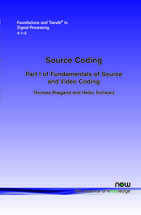Source Coding: Part I of Fundamentals of Source and Video Coding
By Thomas Wiegand, Berlin Institute of Technology and Fraunhofer Institute for Telecommunications — Heinrich Hertz Institute, Germany, thomas.wiegand@tu-berlin.de | Heiko Schwarz, Fraunhofer Institute for Telecommunications — Heinrich Hertz Institute, Germany, heiko.schwarz@hhi.fraunhofer.de
Abstract
Digital media technologies have become an integral part of the way we create, communicate, and consume information. At the core of these technologies are source coding methods that are described in this monograph. Based on the fundamentals of information and rate distortion theory, the most relevant techniques used in source coding algorithms are described: entropy coding, quantization as well as predictive and transform coding. The emphasis is put onto algorithms that are also used in video coding, which will be explained in the other part of this two-part monograph.
Source Coding
Source Coding is the first part of the two-part monograph Fundamentals of Source and Video Coding by Wiegand and Schwarz. It is devoted to the fundamental subject of source coding. Source Coding is a standalone text and also forms the basis for the second part, which describes the application of sources coding techniques to video coding. Based on a simple and accessible presentation of the fundamentals of information and rate distortion theory, the authors describe the subjects of entropy coding and quantization as well as predictive and transform coding. All relevant source coding results that are required for the understanding of today's video compression algorithms are established. The emphasis is on source coding techniques that have become relevant for video coding in recent years. To illustrate the concepts and efficiency of the basic sources coding techniques, the authors provide numerous examples and experimental results for simple model sources. In addition to widely known results, the text also offers some elements that are new or rarely covered in references on source coding today, which include: Huffman coding for variable-length symbol sequences and PIPE coding, scalar quantization in combination with advanced entropy coding techniques, a simple model for the rate distortion performance of entropy-constrained scalar quantization for Gaussian sources that is valid over the entire bit rate range, a proof for the optimality of the Karhunen-Loève transform for Gaussian sources. Source Coding is suitable as a primary text for courses on this subject. It can also be used as a resource for teaching and as a comprehensive reference for professional engineers and academic researches.

Companion
Vdeo Coding: Part II of Fundamentals of Source and Video Coding , Foundations and Trends® in Signal Processing, Volume 10, Issue 1–3 10.1561/2000000078